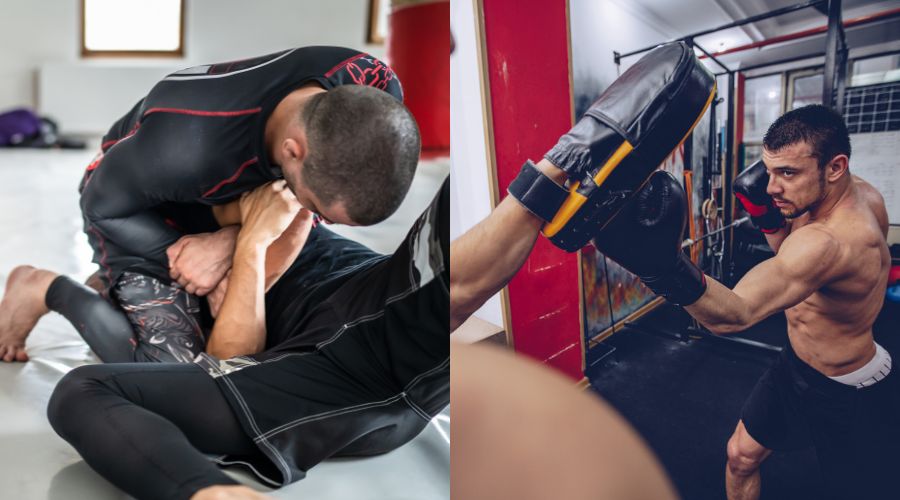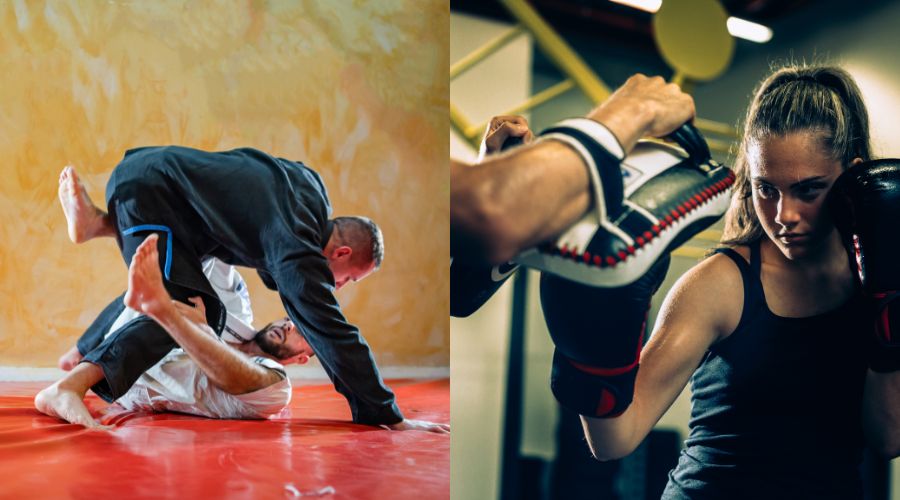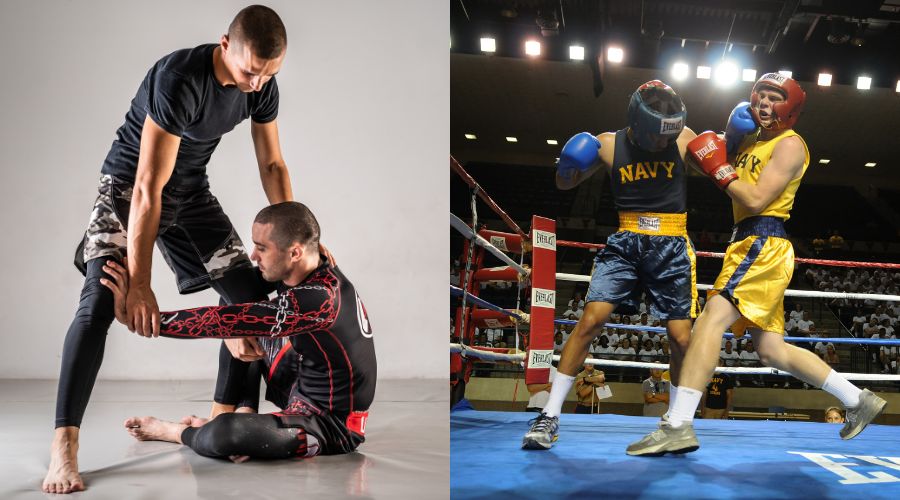Brazilian jiu-jitsu and boxing are two of the most easily distinguished combat sports, and even someone who sees them for the first time will instantly see they are entirely different. Still, they are two important pieces of the complete puzzle called fighting, and because of this, they are often compared and measured against each other. Do you know all the differences between them?
BJJ is a grappling martial art focused on dominating an opponent on the ground through superior positioning and ultimately forcing them to surrender with submission holds. Boxing, on the other hand, is a punching-only, striking combat sport aiming to beat or knock out someone on the feet with your fists.
As different as boxing and BJJ are, they are both tightly specialized in a specific area of fighting and have the mindset of being clean, highly technical, and precise arts. As both are essential parts of MMA and fighting, it is good to know all the details that make them so popular.
What Is BJJ
Brazilian jiu-jitsu is a grappling martial art and sport focused on ground fighting and submissions. Through techniques and the principles of leverage and body mechanics, BJJ provides the means for control and dominance over opponents on the ground, regardless of size differences.
Brazilian Jiu-jitsu, as the name suggests, originated in Brazil after Japanese judoka and jiu-jitsu master Mistyo Maeda traveled to the South American country to teach students and fight in challenges.
The Gracie family, especially brothers Helio and Carlos, learned the skills brought by Maeda but focused more on the ground portion of the fight, gradually changing the style into something new.
Through the many battles with other grappling and fighting styles, which also heavily influenced it, BJJ became the style it is today.
The Gracie family went to the USA to popularize their style, and the enormous success came with the first UFC events won by Royce Gracie purely with his BJJ skills.
The events and early MMA proved the necessity of grappling for real fighting and cemented BJJ as one of the most efficient styles.
BJJ has risen rapidly in popularity in the last two decades and branched into a few different substyles. The most popular form is sports BJJ, a highly regulated grappling-only combat sport, including gi and no-gi versions.
In addition, BJJ is still practiced for self-defense, closely resembling the original art, and as BJJ for MMA.
What Is Boxing
Boxing is a striking combat sport where only punches are allowed. The reliance only on the hands limits all other aspects of fighting but, in turn, takes punching, footwork, and head movement to the highest possible level.
Boxing matches are fought with special padded gloves in a square ring, which many other striking disciplines have adopted.
Boxing is competitive fist fighting and has been a part of history in some form, perhaps since prehistory. The first documented proof dates back to the 3rd millennium BC in Summeria.
Then boxing had an important place in antiquity in Hellenic Greece as a part of the Olympics and in Rome as a part of gladiatorial games.
Then, boxing was lost as a competition and entertainment form for a long time until it resurfaced in 17th-century England, where it started to take its current form.
The first matches were bare-knuckle, but Jack Broughton introduced padded gloves for training, which would later become the norm for matches. The Queensberry Rules largely finalized the form we know boxing today in the late 19th century.
Today, boxing is still the most popular combat sport, being part of the Olympic Games as an amateur discipline and as a professional sport.
Pro boxing is a part of pop culture, has huge prizes and extensive media coverage, and world champions often transcend the sport and become celebrities.
Key Differences Between Boxing and BJJ

Rules and Objectives
While the overarching objective of both sports is to physically dominate another person in a fight, the means of doing so is completely opposite.
Key features and rules of sports BJJ
- Sports BJJ is a grappling contest with no striking allowed.
- The goal is to dominate the opponent, and you can win by submitting or accumulating points.
- Takedowns, sweeps, and dominant positions like side control and mount are awarded points, which determine the winner if, at the end of the match’s time limit, there no submissions were finished.
- Submissions include various strangulations and joint locks, with banned moves depending on the organization and the level of competitors.
- Different variations of sports BJJ include gi, no-gi, submissions-only BJJ, and others with different rulesets.
Key features of professional boxing
- Boxing is a striking sport, with only punches with a closed fist above the waist allowed.
- No grappling is allowed, and clinches are quickly separated
- A match can be won via a knockout or on points
- Matches are divided into rounds, where each round is scored by judges based on factors like damage and number of landed punches. After the final round, if both boxers are still fighting, the fighter with the higher score wins.
Techniques
The techniques are also different because of the different rules and objectives of BJJ and boxing.
Brazilian jiu-jitsu is focused on ground fighting, and takedowns receive little attention, but some fundamental takedowns from wrestling and judo are taught and practiced in BJJ.
The majority of effort is spent on positions and submissions. Positioning is critical, and fighting from the back in various guards like full, open, half, butterfly, and many others is unique to BJJ and not found in any other grappling martial art to the same extent.
Other positions include side control, mount, back mount, knee on belly, and others. The variety of submissions available in BJJ is also unrivaled by other martial arts.
There are countless chokes and joint locks, including popular ones like the guillotine choke, triangle choke, armbar, and Kimura.
Boxing features only punching, so the attacking techniques are limited to straight punches, hooks, uppercuts, and variations.
Because of the limited weapons, boxers develop highly elaborate footwork and head movement to diversify their attacks and defenses.
Equipment
The equipment requirements are very different for boxing and BJJ. Since jiu-jitsu has no striking, you will need less protective equipment, namely just a mouthguard.
For traditional BJJ, you will need a gi and a colored belt. No-gi is practiced in a rash guard on top and BJJ shorts or spats on the bottom.
In boxing, the clothing is not as important, and you can train with regular athletic clothes, but you will need a few more items for protection:
- Boxing gloves
- Mouthguard
- Groin guard
- Headgear
- Boxing shoes
The equipment quality in both sports matters and can save you a lot of unnecessary trouble. I suggest you read our buyer’s guides to find the best quality gear.
BJJ vs. Boxing For MMA

Brazilian jiu-jitsu has been proven to be a mandatory style for success in MMA. As coach Firas Zahabi said, you may not win with a submission in MMA, but if you don’t know BJJ, you will surely lose with a submission.
Early on, BJJ dominated mixed martial arts, and while this is no longer the case, no one can hope to survive without at least a competent defense against common submissions.
With that said, striking is also crucial in the modern era of MMA. Boxing provides an excellent base for MMA, and many fighters have reaped great success with their punching.
Even accomplished grapplers learn to strike and rely on their punches in fights. As we have recently seen from the performance of Kron Gracie, the days of pulling guard and winning without throwing a single strike are long gone.
But while you surely need both competent striking and grappling, ground fighting is more important, and while you can get away with sloppy striking, poor grappling defense is usually catastrophic.
So BJJ is better than boxing for MMA, with the added important note that neither is enough on its own.
BJJ vs. Boxing For Self-Defense

BJJ was first created with self-defense in mind, and its entire concept was based on winning fights against all fighting styles.
Ground fighting allows significant weight differences to be diminished, and getting someone without wrestling experience on the ground is not so difficult. BJJ has been tested so often in no-rules challenges and street fights that its superiority in one-on-one fights is undeniable.
The downside of this approach is you need to commit to being on the ground, removing the option for a quick escape. Furthermore, if the person you are fighting has some friends, they can undisturbedly attack you on the ground.
Through the techniques taught in BJJ, you can control and neutralize an opponent without causing much harm, making it a reasonable choice for law enforcement. So, against a single attacker, BJJ is amazing, but in other situations, it is less than ideal.
Boxing, on the other hand, is severely lacking in grappling. Most fights end up in a clinch or on the ground, and boxers are rarely good in those positions.
But where pugilism shines is in the punching, which is the safest and fastest way to end a fight. Often the best choice is to hit hard and fast and escape danger, and boxing provides the perfect tools.
Who Would Win A Fight Between BJJ and Boxing?
In a fight between a pure boxer and a BJJ practitioner, the grappler wins 9 out of 10 fights. This style vs. style matchup has been tried many times in reality, and the result is always the same. The BJJ guy always takes down the boxer and effortlessly submits him.
But if the boxer has at least some takedown defense, the situation can take a dramatic turn, so in today’s era, where people are well aware of how real fights play out and cross-train, at least partially, it depends a lot on the person. But as I’ve said, BJJ takes it every day in a pure style vs. style fight.
BJJ vs. Boxing Which Is Better?
BJJ and boxing represent two opposite approaches to fighting but share a common level of specialization. And as we know, specialization breeds complete mastery in one area. Both are well-respected, extensively developed, and widely available combat sports.
If you want to strike, boxing is always one of the first choices you should consider. BJJ will be your favorite if you don’t like to be hit in the head and prefer a methodical and clean grappling approach. Both provide structure and opportunities for competition, are viable career paths, and have large communities you can be a part of.
So, none can be called better than the other. Many factors can determine the choice between the two, but whatever it is, I assure you that you will greatly benefit. And if you want to be a more well-rounded martial artist, skills in both are mandatory.
